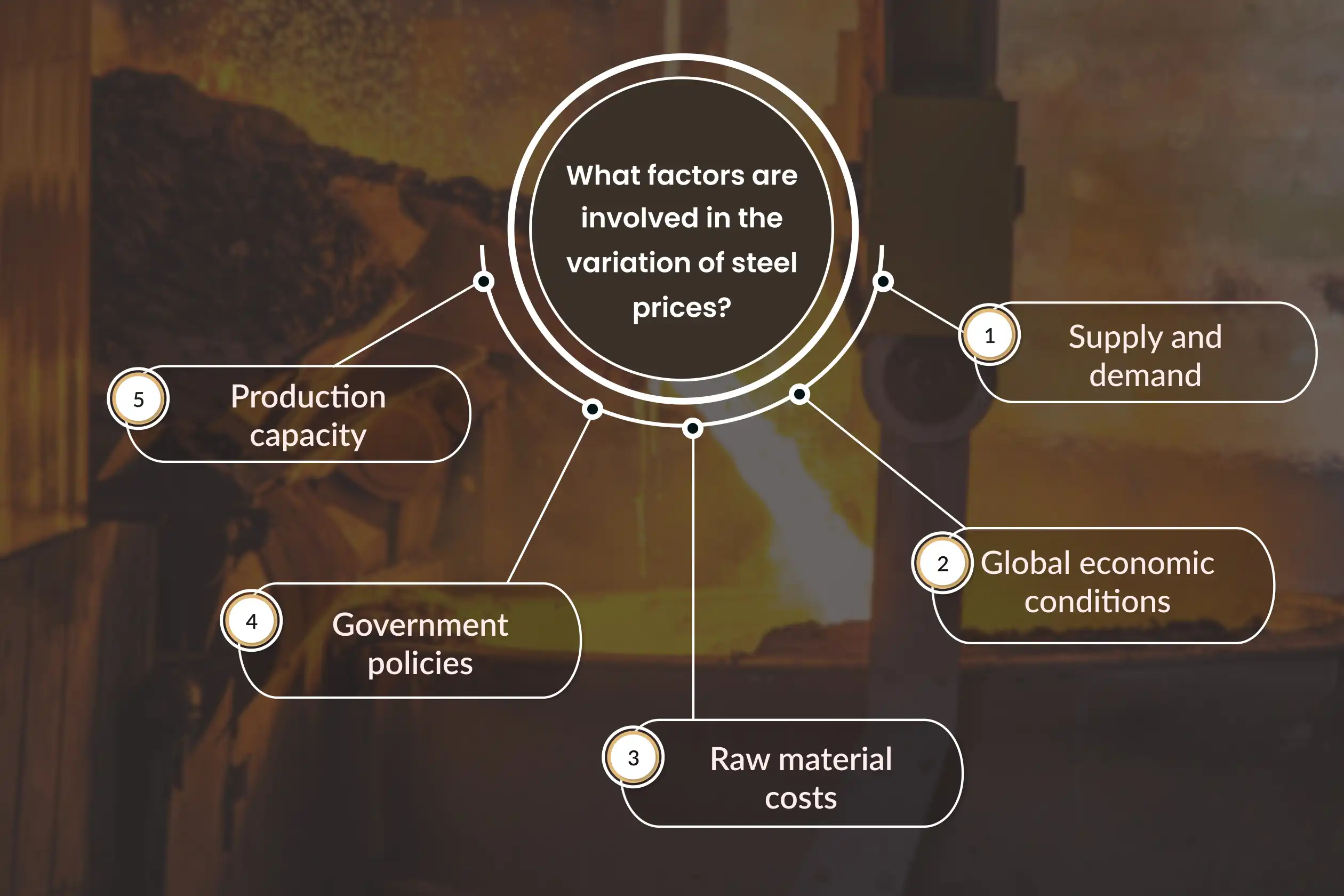What is driving the fluctuation in steel prices?

Introduction:
If you've ever walked through a construction site, you've probably seen it: towering steel beams rising up towards the sky, slowly taking shape into the building of tomorrow.
But what you might not see is the complex web of factors that influence the price of that steel, and how they can cause its cost to soar or plummet. From the global economy to the production capacity of steel mills, the forces driving the fluctuation in steel prices are as massive and intricate as the structures they help build.
So let's grab our hard hats and take a closer look at what's behind these price fluctuations, and how they impact the construction industry and beyond
What factors are involved in the variation of steel prices?
Steel is one of the most important and widely used materials in the modern world, forming the backbone of our buildings, infrastructure, and transportation systems.
But what drives the fluctuation in its price? From the raw materials that go into its production to global economic trends, there are a variety of factors that can impact the cost of steel. As the demand for this vital resource continues to grow, it's important to understand the complex interplay of these factors and how they can impact the price of steel over time.
So, let's dive into the key factors involved in the variation of steel prices, and explore their impact on industries and economies around the world.

Supply and demand:
The most fundamental factor affecting steel prices is supply and demand. When demand for steel is high and supply is limited, prices tend to rise. Conversely, when supply is high and demand is low, prices tend to fall.
Global economic conditions:
The global economy has a significant impact on steel prices. For example, when the economy is growing, demand for steel tends to increase, which can lead to higher prices. On the other hand, during times of economic recession or slowdown, demand for steel can decline, leading to lower prices.
Raw material costs:
The cost of raw commodities such as iron ore, coal, hot-rolled coil, and scrap metal can also impact steel prices. When the cost of these materials increases, it can lead to higher steel prices.
Government policies:
Government policies, such as tariffs and trade agreements, can also impact steel prices. For example, tariffs on steel imports can increase the price of domestically produced steel, while free trade agreements can lead to increased competition and lower prices.
Production capacity:
The production capacity of steel mills can also impact prices. When production is running at full capacity, prices tend to be lower due to increased supply. On the other hand, when production is limited, prices tend to be higher due to limited supply.
Are supply chain logistics affected by the geopolitical environment?
Yes, the geopolitical environment can have a significant impact on supply chain logistics. The geopolitical environment refers to the political, social, and economic factors in a region or country, and how they interact with other nations and global trends.
Any disruptions to the geopolitical environment can affect the supply chain logistics of goods and services in several ways, including
Border closures and trade restrictions:
Changes in geopolitical relationships between countries can lead to border closures and trade restrictions, making it difficult to transport goods across borders. This can result in delays, increased costs, and even shortages of certain goods.
Transportation infrastructure:
The geopolitical environment can also impact the transportation infrastructure in a region or country, which can affect the flow of goods. For example, political instability or conflict can lead to damage or destruction of roads, railways, and ports, making it difficult to transport goods to their destination.
Changes in regulations:
Changes in regulations related to trade, tariffs, and customs can also impact the supply chain logistics of goods and services. This can include changes in import and export regulations, which can increase the time and cost of moving goods across borders.
Access to resources:
Geopolitical changes can also impact access to resources such as raw materials and energy, which are essential to many industries. This can lead to supply chain disruptions and higher costs for businesses that rely on these resources.
Is the demand for steel being driven up by the real estate and automotive industries?
Yes, the demand for steel is being driven up by the real estate and automotive industries, among others. Steel is a key material used in both the construction of buildings and the manufacturing of automobiles, as well as many other industrial applications. As these industries continue to grow and expand, the demand for steel is also increasing.
In the real estate industry, steel is used in the construction of buildings, including everything from the frame to the reinforcing bars in the concrete. As population continue to grow and urban areas expand, the demand for new construction is increasing, which in turn is driving up the demand for steel.
Similarly, in the automotive industry, steel is used in the production of vehicles, including the frame, body, and engine components. As the global population continues to grow and the demand for automobiles increases, the demand for steel is also rising.
Other industries that use steel, such as infrastructure and manufacturing, are also contributing to the increased demand for this material.
How long is current price volatility in steel anticipated to last? (Medium /long term)
Predicting the duration of price volatility in the steel industry is challenging, as it depends on a range of factors such as global economic conditions, changes in supply and demand, geopolitical factors, and other external events that can impact the industry.
However, some experts predict that the current price volatility in the steel industry could persist in the medium to long term.
One factor contributing to the current volatility is the pandemic and its ongoing impact on global supply chains.
The COVID-19 pandemic has caused disruptions in the production and transportation of goods, leading to increased demand and limited supply of certain products, including steel. Additionally, trade tensions between major steel-producing countries have also contributed to the volatility in steel prices.
Another factor is the ongoing transition to sustainable and renewable energy sources, which is driving demand for steel in the production of renewable energy infrastructure such as wind turbines and solar panels. This increased demand could further drive up prices.
Conclusion:
In conclusion, the fluctuation in steel prices is being driven by a complex interplay of factors. On the supply side, disruptions to the global supply chain, including shortages of key raw commodities such as iron ore, hot-rolled coil, and coking coal, have led to price increases.
On the demand side, growing demand from a range of industries, including real estate, automotive, and infrastructure, is driving up the price of steel. In addition, geopolitical tensions and trade policies are contributing to price volatility. The ongoing transition to sustainable and renewable energy sources is also expected to further increase demand for steel.
You can always check and stay updated about price fluctuations with the help of AI/ML price forecasting websites that keep you away from any losses.
While the duration of the current price volatility in the steel industry is uncertain, it is expected to persist in the medium to long term as the industry continues to adapt to changing global economic and environmental conditions.